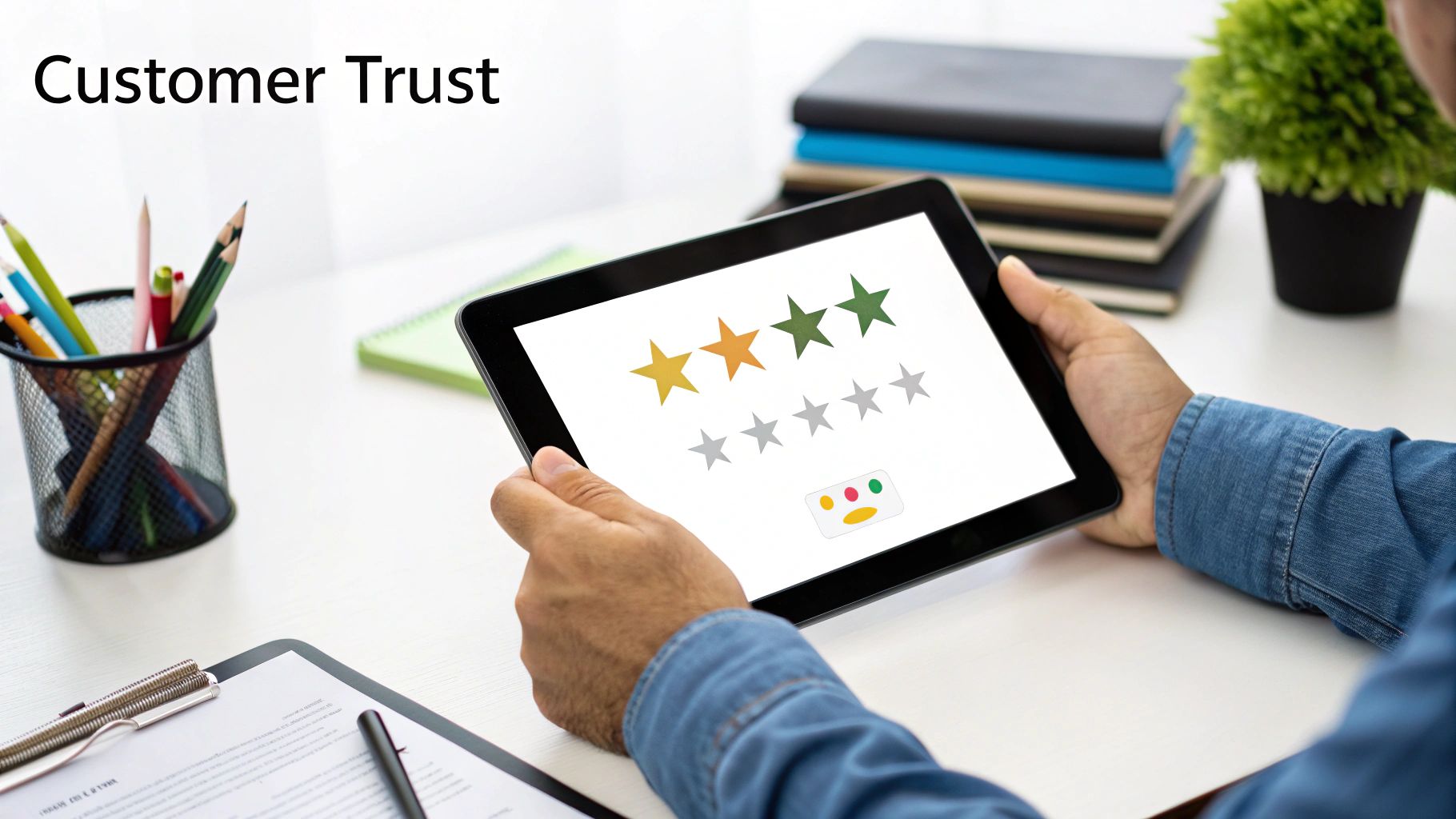
10 Persuasive Writing Techniques to Master LinkedIn in 2025
Published on 2025-10-08
In the crowded feed of LinkedIn, a great idea isn't enough. You have to make it compelling. The difference between a post that gets scrolled past and one that sparks meaningful conversation often comes down to the art of persuasion. This isn't about manipulation; it's about authentic connection. True influence comes from understanding how to build trust, stir emotion, and present logic in a way that truly resonates with your audience.
This guide is designed to be your practical playbook. We will break down 10 foundational persuasive writing techniques, transforming them from abstract concepts into concrete tools for your very next LinkedIn post. For each strategy, we'll move beyond theory and give you actionable steps to apply them immediately, helping you craft content that not only stops the scroll but also builds a loyal professional following. To broaden your understanding, explore these seven powerful persuasive writing techniques that can further hone your ability to influence.
Ready to elevate your writing from simply being seen to being truly influential? Let's dive into the specific methods that will make your message stick.
1. Ethos (Ethical Appeal)
Ethos is one of the most powerful persuasive writing techniques because it’s all about building trust. It convinces your audience by establishing your credibility, authority, and character. Before anyone will listen to your message, they must first believe you are a reliable source worth their time and attention. This appeal makes your audience see you as qualified and trustworthy.

Think of a doctor citing their years of experience before giving health advice or a financial advisor highlighting their successful track record. They are using ethos to build a foundation of trust. By demonstrating expertise and good character, you make your arguments significantly more convincing.
How to Use Ethos on LinkedIn
To leverage this ethical appeal in your content, focus on showcasing your expertise authentically. Your goal is to prove you're a credible voice in your field without sounding arrogant.
- Display Your Credentials: Mention your relevant experience, certifications, or accomplishments early in your post. For example, start with, "After 10 years in SaaS marketing, I've learned one thing about user retention..."
- Cite Authoritative Sources: Back up your claims by referencing respected studies, industry leaders, or data-driven reports. This shows you've done your research.
- Maintain Consistency: Ensure your messaging and values are consistent across all your posts. This builds a predictable and reliable personal brand over time. Establishing this consistency is a core principle of professional writing. For a deeper dive, explore our guide on the ethics of ghostwriting and maintaining an authentic voice.
2. Pathos (Emotional Appeal)
Pathos is a persuasive writing technique that appeals directly to an audience's emotions. It aims to evoke feelings like compassion, joy, anger, or fear to create a powerful connection and motivate action. Instead of relying purely on logic, pathos influences your audience by tapping into their values, desires, and deepest concerns.

Think of a charity campaign showing heart-wrenching images to inspire donations or an advertisement that uses humor to make a brand feel relatable and likable. These examples use pathos to bypass purely rational thought and create an immediate, gut-level response. By stirring emotions, you make your message more memorable and compelling.
How to Use Pathos on LinkedIn
To leverage this emotional appeal, you must connect with your audience on a human level. Your goal is to tell stories and share insights that resonate emotionally, making your professional content more impactful and memorable.
- Tell Relatable Stories: Share a personal story about a challenge you overcame or a lesson you learned. For instance, "I almost gave up on my business in year two. Here’s the vulnerable story of what kept me going..." This builds empathy and connection.
- Use Vivid Language: Paint a picture with your words. Use sensory details to help your audience feel the emotions you are describing. Instead of saying you were "happy," describe the "unshakeable grin that I couldn't wipe off my face."
- Focus on Your Audience's Aspirations: Tap into your audience’s professional hopes and fears. Frame your solution not just as a business tool but as a way to achieve a desired feeling, such as confidence, security, or relief from stress.
3. Logos (Logical Appeal)
Logos is a persuasive writing technique that appeals directly to your audience’s sense of reason. It’s all about using logic, facts, data, and evidence to construct a compelling argument. Instead of relying on emotion or credibility, logos convinces people by presenting an undeniable case supported by objective information. This technique works because it speaks to the rational mind, guiding the audience to a logical conclusion.

Think of a company presenting a case study with hard numbers to prove their product's ROI, or an analyst using market data to predict future trends. They are using logos to build an argument that is difficult to refute. By grounding your claims in solid evidence, you demonstrate that your perspective is not just an opinion, but a well-reasoned conclusion.
How to Use Logos on LinkedIn
To effectively use this logical appeal, you must present your information clearly and back up every claim with proof. Your goal is to make your argument so sound that the audience arrives at your conclusion on their own.
- Use Specific Data and Statistics: Instead of saying a strategy is "effective," say it "increased user engagement by 45% in Q3." Quantifiable results are far more persuasive.
- Structure a Logical Flow: Build your argument step by step. Start with a clear premise, provide supporting evidence, and end with a logical conclusion that ties everything together.
- Cite Credible Sources: When you share data or a statistic, mention where it came from. Linking to a respected industry report or study adds a layer of validation to your claims.
4. Social Proof
Social proof is a powerful psychological trigger that encourages people to follow the actions of others. It’s based on the idea that if many people are doing something, it must be the correct and desirable choice. This persuasive writing technique leverages testimonials, user counts, and positive reviews to build trust by showing that others have already validated your product, service, or idea.

Think of how Amazon displays customer ratings or how a SaaS company boasts about its "10 million trusted users." They are using social proof to reduce uncertainty and make the decision to buy feel safer and more popular. By highlighting the positive experiences of others, you make your own claims far more believable and compelling.
How to Use Social Proof on LinkedIn
To leverage this technique in your content, focus on showcasing external validation in an authentic and quantifiable way. Your goal is to let your happy customers and audience members do the selling for you.
- Share Concrete Numbers: Use specific data to demonstrate adoption and trust. For instance, "We're thrilled that over 50,000 professionals have downloaded our latest guide..." This is more impactful than a vague statement.
- Feature Authentic Testimonials: Post screenshots of positive client feedback or share a direct quote with their permission. Including their name, photo, and title adds a layer of credibility that resonates with your audience.
- Highlight User-Generated Content: If customers share how they use your product or service, reshare it. This is one of the most genuine forms of social proof and shows your solution creates real-world value for real people.
5. Scarcity and Urgency
Scarcity and urgency are persuasive writing techniques that tap into our fear of missing out (FOMO). This approach convinces an audience to act by highlighting limited availability, either in quantity (scarcity) or time (urgency). When people believe a valuable opportunity is about to disappear, they are psychologically motivated to act quickly to avoid the pain of a potential loss.
Think of an e-commerce site showing "Only 2 left in stock" or a webinar promotion that states, "Early bird pricing ends Friday." These messages create a sense of pressure that bypasses lengthy decision-making. By framing an offer as a fleeting opportunity, you make it seem more valuable and encourage immediate action.
How to Use Scarcity and Urgency on LinkedIn
To leverage scarcity and urgency, you must create a genuine sense of exclusivity or a limited window of opportunity. This technique is highly effective for driving sign-ups, sales, or engagement on specific posts.
- Set Clear Limitations: Be specific about what is limited. Instead of saying "limited spots," say "I'm only taking 5 new clients this month." Instead of "for a limited time," use "This offer expires at midnight on Friday."
- Offer Exclusive Access: Frame your content or offers as exclusive to a select group. For example, "The first 20 people to comment on this post will get a free copy of my new ebook."
- Be Authentic: This technique loses its power if overused or fabricated. Only apply scarcity when it is real. Creating false urgency will damage your credibility and make your audience distrust future offers. Your long-term reputation is more important than short-term clicks.
6. Reciprocity
Reciprocity is a persuasive writing technique that taps into our innate human desire to return a favor. This powerful social principle suggests that when you give someone something of value for free, they feel a natural obligation to give something back. In writing, this means providing genuine value upfront before asking for anything in return, making your audience more receptive to your eventual request.
Think of a software company offering a free trial or an author giving away the first chapter of their book. These gestures are not just marketing; they are strategic acts of giving that create a psychological need to reciprocate. By offering valuable content or tools, you build goodwill and make your audience more likely to engage, subscribe, or buy.
How to Use Reciprocity on LinkedIn
To leverage this principle, focus on giving away high-value insights, advice, or resources without immediate expectations. Your goal is to be genuinely helpful, which in turn builds a loyal audience that wants to support you.
- Offer Valuable Content: Share free templates, checklists, or in-depth guides that solve a real problem for your audience. For example, "I created a free content calendar template to help you stay organized. Grab your copy here..."
- Give First, Ask Later: Follow Gary Vaynerchuk's "Jab, Jab, Jab, Right Hook" model. Provide value consistently in multiple posts (the jabs) before making an ask (the right hook), like promoting a webinar or service.
- Personalize Your Help: When someone asks a question in the comments, provide a thoughtful, detailed answer. This public act of generosity demonstrates your expertise and willingness to help, encouraging others to engage with your content.
7. Storytelling and Narrative
Facts tell, but stories sell. This is the core principle behind using storytelling as one of the most powerful persuasive writing techniques. Instead of just presenting data or direct arguments, storytelling engages your audience on an emotional level by framing your message within a narrative structure complete with characters, conflict, and resolution. This technique helps make abstract concepts feel concrete and relatable.
Storytelling works by bypassing the audience's natural logical resistance. A good narrative pulls them into a journey, allowing them to visualize the message rather than just analyze it. Think of Apple's product launches, which often frame new technology as the next chapter in an epic story of innovation, or Nike's ads that focus on an athlete’s journey rather than just the shoes. These narratives make the message memorable and deeply resonant.
How to Use Storytelling and Narrative on LinkedIn
To leverage storytelling in your content, you must turn your message into a compelling narrative that connects with your audience’s own experiences and aspirations. The goal is to make your point unforgettable.
- Start with a Relatable Character: Begin your post with a person or situation your audience can identify with. For example, "My first client was terrified of public speaking. He'd freeze up in every meeting..."
- Show Transformation: A powerful story always involves change. Detail the "before" and "after" to illustrate the impact of your idea, product, or service. Show the journey from a problem to a solution.
- Align the Story with Your Message: Ensure your narrative directly supports the key takeaway you want to leave with your audience. The story should be the vehicle for your message, not a distraction. For more inspiration, explore these effective business storytelling examples that drive results.
8. The Power of 'Because' (Reason-Giving)
The power of ‘because’ is a simple yet profound persuasive writing technique that taps into our innate desire for reasons. Humans are hardwired to look for explanations, and providing a justification for a request or statement, even an obvious one, dramatically increases compliance. This technique works by satisfying the brain’s need for causality, making your message feel more logical and legitimate.
This principle was famously demonstrated in a study by Harvard psychologist Ellen Langer. When someone asked to cut in line at a copy machine, simply adding “because I have to make some copies” boosted the success rate from 60% to 94%. This highlights that the mere presence of a reason, not necessarily its strength, is a powerful persuasive trigger.
How to Use ‘Because’ on LinkedIn
You can integrate this reason-giving approach into your LinkedIn content to make your claims, advice, and calls to action more compelling. The goal is to justify your statements to remove audience skepticism and encourage action.
- Justify Your Claims: When presenting an opinion or data, immediately follow it with a reason. For example, "Our team is switching to asynchronous communication because it empowers employees to manage their own schedules, boosting productivity."
- Strengthen Your Call to Action: Don't just ask your audience to do something; tell them why. Instead of "Download our new e-book," try "Download our new e-book so that you can learn the five frameworks that doubled our Q3 revenue."
- Explain Your Process: When sharing a success story or case study, explain the reasoning behind your strategy. For example, "We limited access to our beta program because we wanted to provide personalized, high-touch support to our first users." This builds trust and positions you as a thoughtful expert.
9. Repetition and Consistency
Repetition and consistency are persuasive writing techniques that reinforce your message by presenting it multiple times. This method works by leveraging a psychological principle called the mere-exposure effect, where people develop a preference for things simply because they are familiar with them. When an audience hears your core message repeatedly, it becomes more memorable, believable, and impactful.
Think of Martin Luther King Jr.’s “I Have a Dream” speech, where the titular phrase is repeated to build emotional power and drive the central theme home. Similarly, political slogans like Barack Obama's "Yes We Can" or brand taglines like Apple's "Think Different" are repeated across all materials to create a lasting, unified impression. This consistency builds a powerful, recognizable identity for an idea or brand.
How to Use Repetition and Consistency on LinkedIn
To make your message stick, you must repeat your core ideas strategically without becoming monotonous. Your goal is to create familiarity and reinforce your key takeaway, making it a central part of your professional brand.
- Identify Your Core Message: Before you write, decide on the single most important idea you want your audience to remember. Make this the anchor of your post and find ways to re-emphasize it.
- Use the Rule of Three: A classic persuasive technique is to present a key point or phrase three times. Introduce it, elaborate on it, and then summarize with it to maximize retention.
- Vary Your Phrasing: Repeat the concept, not necessarily the exact words. You could say, "Customer feedback is crucial," then later, "Listening to your users is non-negotiable," and finally, "Never ignore what your customers are telling you."
- Maintain Cross-Post Consistency: Ensure your core message is consistent across all your LinkedIn posts and other content channels. For more on this, our guide on effective business writing offers further insights into maintaining a coherent professional voice.
10. Addressing Counterarguments (Preemption)
Addressing counterarguments is a sophisticated persuasive writing technique where you anticipate and respond to potential objections before your audience even voices them. This approach, also known as preemption or refutation, strengthens your argument by demonstrating that you have considered the topic from all angles. It builds credibility and shows intellectual honesty, making your position appear more robust and well-reasoned.
By tackling potential doubts head-on, you disarm critics and prevent your audience from getting stuck on unanswered questions. Think of a sales page that includes a detailed FAQ section addressing price concerns, or a product review that acknowledges a minor flaw but explains why the benefits far outweigh it. You are guiding the conversation and neutralizing resistance preemptively.
How to Use Preemption on LinkedIn
Using this technique on LinkedIn shows confidence in your position and respect for your audience's intelligence. It proves you aren't afraid to engage with opposing views, which builds significant trust.
- Anticipate Common Objections: Before posting, think about the likely pushback. What will skeptics say? Start your post by acknowledging it directly: "I know what you're thinking: 'Isn't this just another marketing fad?' Let me explain why it's different..."
- Concede and Reframe: Acknowledge a valid point from an opposing view before refuting it. For example, "While it's true that implementing a new CRM can be costly upfront, the long-term ROI from improved customer retention is undeniable."
- Frame Objections as Questions: Pose common counterarguments as questions to create an engaging, conversational tone. For instance, "But what about the time commitment? That's a fair question. Here’s a three-step process to make it manageable."
Persuasive Techniques Comparison Table
| Technique | Implementation Complexity 🔄 | Resource Requirements ⚡ | Expected Outcomes 📊 | Ideal Use Cases | Key Advantages ⭐ / Insights 💡 |
|---|---|---|---|---|---|
| Ethos (Ethical Appeal) | Medium - requires sustained credibility building | Moderate - credentials, endorsements | Builds trust and authority over time | Professional communication, academic writing, brand building | Creates long-term loyalty; enhances all arguments; maintain consistency 💡 |
| Pathos (Emotional Appeal) | Medium - crafting emotional stories | Moderate - storytelling skills, audience insight | Motivates immediate action with emotional impact | Fundraising, advertising, political campaigns | Strong emotional connection; bypasses logic resistance; use vivid, authentic stories 💡 |
| Logos (Logical Appeal) | High - research and evidence gathering | High - data, statistics, logical structuring | Persuades rational, analytical audience | Academic writing, business proposals, policy arguments | Difficult to refute; builds credibility; use clear, structured arguments |
| Social Proof | Low - collecting and displaying testimonials | Low to moderate - gathering reviews and endorsements | Builds quick trust via social validation | E-commerce, marketing, product launches | Reduces risk perception; leverages conformity; authenticity critical 💡 |
| Scarcity and Urgency | Low to medium - setting limits and deadlines | Low - messaging and UI elements | Drives fast action and higher perceived value | Sales, promotions, event marketing | Creates FOMO; increases conversions; honesty essential to maintain trust |
| Reciprocity | Medium - providing upfront value without direct ask | Moderate - content creation or free offerings | Builds goodwill and encourages reciprocation | Content marketing, lead gen, brand authority | Natural persuasion; effective long-term; value must be genuine 💡 |
| Storytelling and Narrative | High - requires creativity and narrative skill | High - crafting compelling stories | Engages and is memorable emotionally and cognitively | Brand marketing, presentations, fundraising | Makes complex ideas relatable; transcends cultures; keep narrative focused 💡 |
| The Power of 'Because' (Reason-Giving) | Low - integrate reasons into requests | Low - simple insertion of causal phrases | Increases compliance significantly | Requests, calls-to-action, explanations | Easy to apply; reason—even weak ones—increases acceptance; avoid overexplaining |
| Repetition and Consistency | Medium - strategically repeating messages | Low to moderate - content planning | Improves retention and message acceptance | Speeches, advertising, political campaigns | Builds familiarity and trust; use variation and rhythm; avoid annoyance 💡 |
| Addressing Counterarguments (Preemption) | High - requires research and balanced refutations | Moderate - gathering opposing views and evidence | Strengthens credibility and neutralizes objections | Persuasive essays, debates, sales copy | Builds trust through transparency; anticipate audience doubts; avoid strawmen |
Putting Persuasion into Practice: Your Next Steps
You've just walked through a comprehensive toolkit of ten powerful persuasive writing techniques. From the classical appeals of Ethos, Pathos, and Logos to modern psychological triggers like Social Proof and Scarcity, you now possess the strategic building blocks for crafting messages that don't just inform, but truly influence.
The journey from knowing to doing, however, is where real growth happens. The goal isn't to cram every single one of these methods into your next LinkedIn post. That would create a confusing and inauthentic message. Instead, the art of persuasion lies in selecting the right tool for the right moment, for the right audience.
From Theory to Action
Mastery begins with a single, deliberate step. Rather than feeling overwhelmed by options, focus on intentional practice. Your next piece of content is the perfect laboratory.
Here’s a simple framework to get you started:
- Define Your Goal: What specific action do you want the reader to take? Is it to comment, visit a link, or simply shift their perspective on a topic?
- Choose Your Tool: Based on your goal, select just one or two persuasive writing techniques from this list. If you want to build trust, lean into Ethos. If you need to drive sign-ups for a limited-time offer, combine Scarcity with Logos.
- Craft and Refine: Write your post with that specific technique as its foundation. Ask yourself: "Does every sentence support my chosen appeal?"
- Review and Learn: After you post, analyze the engagement. Did the emotional hook land? Did the logical argument resonate? Every post is a data point that hones your intuitive understanding.
Why This Matters More Than Ever
In a digital world saturated with content, simply being present isn't enough. Your ability to connect, convince, and compel is your greatest competitive advantage. Mastering these persuasive writing techniques transforms your communication from a monologue into a dialogue, turning passive readers into active participants, followers into loyal community members, and prospects into valued clients.
This isn't about manipulation; it's about connection. It's about presenting your ideas, products, and vision in a way that resonates deeply and inspires action. As you become more adept at wielding these tools, you'll not only see your engagement metrics climb, but you'll also build a more meaningful and influential professional presence. Start today, one technique at a time.
Ready to put these persuasive writing techniques into action but short on time? Let autoghostwriter help you craft compelling, on-brand LinkedIn content that leverages these powerful principles, turning your ideas into influential posts in a fraction of the time. Visit autoghostwriter to see how AI can amplify your persuasive power.